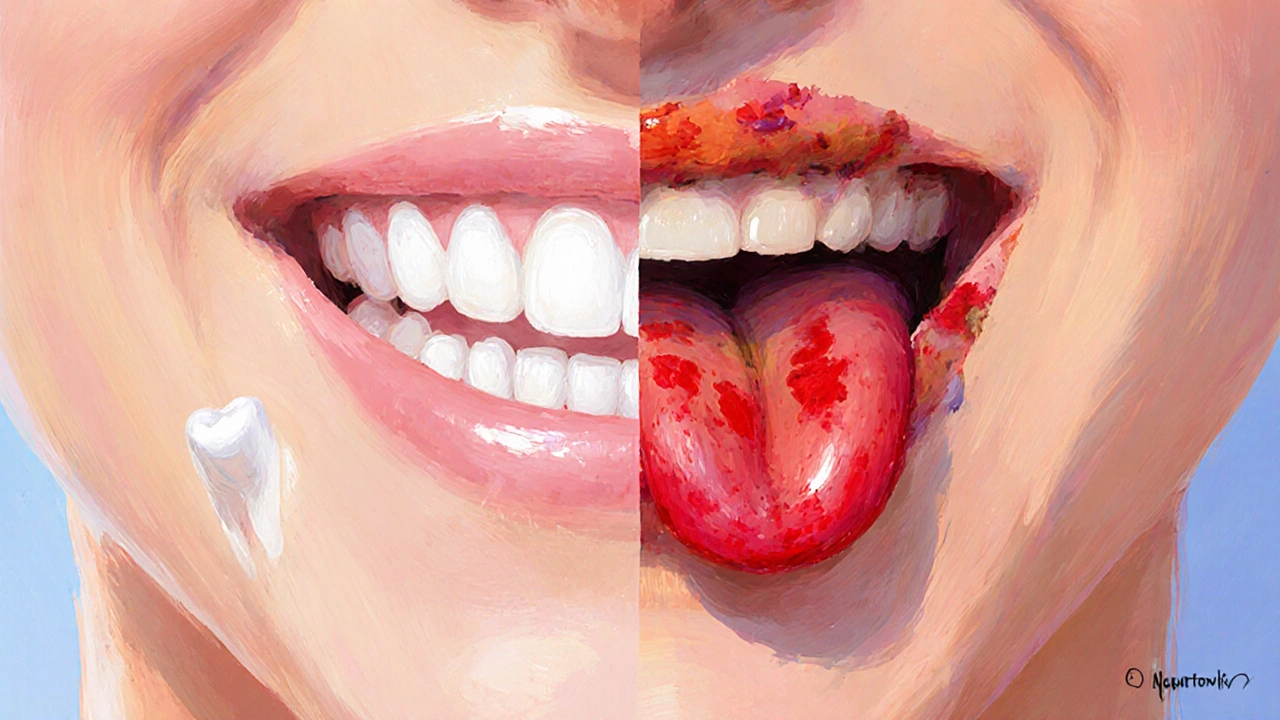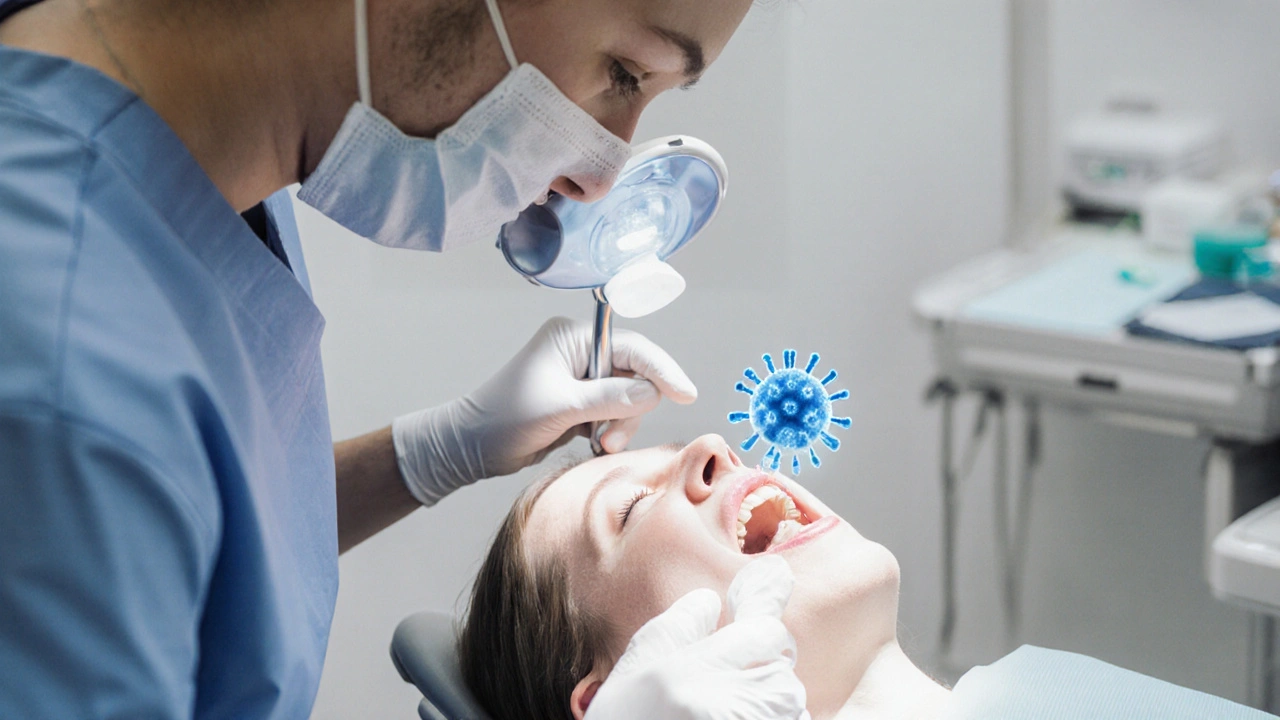Oral Cancer Symptom Checker
Check for Potential Oral Cancer Warning Signs
Answer the following questions about your symptoms. This tool is for educational purposes only and does not replace professional medical advice.
Most of us have felt a dull ache after a bad meal or a cracked tooth, but sometimes that pain hides something far more serious. If a toothache lingers beyond a week, shows up without a clear dental cause, or comes with odd mouth changes, it could be an early warning of oral cancer signs. This guide breaks down what to watch for, why the link exists, and how to act fast.
What Is Oral Cancer?
Oral Cancer is a group of malignant tumors that develop in the tissues of the mouth, tongue, lips, gums, or floor of the mouth. The most common type, accounting for about 90% of cases, is Squamous Cell Carcinoma, which starts in the thin, flat cells lining the oral cavity.
According to the World Health Organization, roughly 300,000 new cases arise worldwide each year, and early detection can boost five‑year survival from below 50% to over 80%.
How Toothaches Usually Feel vs. Cancer‑Related Pain
Toothache typically stems from decay, infection, gum disease, or trauma. The pain is sharp, localized, and often worsens with hot or cold stimuli. It may respond to over‑the‑counter analgesics and improves after dental treatment.
By contrast, pain linked to oral cancer can be persistent, dull, or throbbing, and may not follow the usual trigger‑response pattern. It can radiate to the ear, jaw, or neck, and often comes with other visual changes in the mouth.
Red‑Flag Signs That Link Tooth Pain to Oral Cancer
Below is a quick side‑by‑side look at typical dental pain versus warning signs of malignancy:
| Feature | Typical Toothache | Potential Cancer‑Related Pain |
|---|---|---|
| Duration | Days to a week, improves with treatment | Weeks to months, no relief |
| Location | Clearly tied to a tooth or socket | Diffuse, may span multiple teeth or soft tissue |
| Trigger | Heat/cold, pressure on the tooth | Often unrelated to temperature; may worsen at night |
| Accompanying signs | Swelling, decay visible | White or red patches (leukoplakia, erythroplakia), persistent ulcer, unexplained bleeding, numbness |
| Response to meds | Improves with ibuprofen or antibiotics | Little to no change |
Key visual cues to watch for include:
- Leukoplakia - thick, white patches that don’t scrape off.
- Erythroplakia - bright red, velvety lesions that are more likely to be malignant.
- Persistent ulcer that won’t heal in 2-3 weeks.
- Unexplained swelling or a lump in the neck (often a sign of Lymph Node Swelling).

Major Risk Factors You Can Control
Understanding what fuels oral cancer helps you lower your odds. The top contributors are:
- Tobacco Use - smoking cigarettes, cigars, pipes, or using smokeless tobacco raises risk by up to 15‑fold.
- Alcohol Consumption - heavy drinking synergizes with tobacco to multiply cancer risk.
- Human Papillomavirus (HPV) infection, especially HPV‑16, is a leading cause of cancers on the tonsils and base of the tongue.
- Chronic irritation from poorly fitting dentures or sharp teeth.
- Age (most cases appear after 50) and a family history of head‑and‑neck cancers.
Cutting back on tobacco and alcohol, maintaining good oral hygiene, and getting the HPV vaccine can dramatically reduce risk.
Getting the Right Check‑up: Who to See and What to Expect
If any red‑flag appears, schedule an appointment ASAP. Your first stop is usually a Dentist. They will perform a thorough Oral Examination, checking for lumps, tissue changes, and abnormal sensations.
Should the dentist suspect malignancy, they’ll refer you to an Oncologist or an oral‑maxillofacial surgeon for a definitive diagnosis. The gold‑standard test is a Biopsy - a small tissue sample examined under a microscope.
Imaging (CT, MRI, or PET scans) may follow to assess spread, but the biopsy result drives treatment planning.
Early Detection Tools and When to Act
Besides professional exams, you can use simple self‑screening steps:
- Stand in front of a mirror with good lighting.
- Open your mouth wide and look at the tongue, inner cheeks, floor, and roof of the mouth.
- Use a clean cotton swab to gently feel for lumps under the jaw or neck.
- Note any persistent pain, numbness, or color changes lasting more than two weeks.
If anything feels off, write down the date you first noticed it and book a dental visit within a week. Early intervention not only improves survival but also often means less aggressive treatment.

Quick Checklist for Self‑Monitoring
- Is the pain lasting longer than 10 days without an obvious dental cause?
- Do you see white or red patches that won’t scrape off?
- Is there an ulcer that hasn’t healed in 3 weeks?
- Do you feel a lump in the neck or under the jaw?
- Any numbness in the tongue, lip, or gums?
Answering ‘yes’ to any of these signals a prompt professional evaluation.
Bottom Line: Don't Ignore Persistent Tooth Pain
Most toothaches are harmless, but a stubborn ache paired with unusual mouth changes can be the first hint of Oral Cancer. Knowing the warning signs, managing risk factors, and seeking early care are the best defenses.
Frequently Asked Questions
Can a simple cavity cause the red‑flag signs listed?
A cavity can cause pain and swelling, but it rarely produces white or red patches, persistent ulcers, or unexplained neck lumps. Those features usually indicate something beyond decay.
How often should I get a professional oral cancer screen?
If you have risk factors (tobacco, heavy alcohol, HPV), aim for an annual oral cancer exam. Otherwise, a routine dental check‑up every six months typically includes visual screening.
Is a biopsy painful?
A biopsy involves a local anesthetic, so you feel little to no pain during the procedure. You might experience mild soreness afterward, which resolves in a few days.
Can oral cancer appear without any pain?
Yes. Early lesions can be painless, especially if they’re flat or located on the tongue’s underside. That’s why visual checks are crucial even when you feel fine.
Does the HPV vaccine protect against oral cancer?
The vaccine targets the HPV strains most linked to head‑and‑neck cancers, including oral cancers. Vaccinated individuals have a significantly lower risk of HPV‑related oral tumors.


Jillian Rooney
October 6, 2025 AT 14:35Yo, if u keep ignorein that tooth ache u might be doin yourself a disservice.
Rex Peterson
October 20, 2025 AT 11:55One might contemplate the epistemic value of early detection in the realm of oral health.
While a toothache is oft dismissed as a trivial nuisance, it may serve as an ontological indicator of deeper pathology.
The intersection of symptomatology and causality invites us to scrutinize the phenomenological experience of pain.
Consequently, a systematic appraisal of persistent discomfort aligns with the virtue of prudence.
In this light, the guidelines presented in the article merit both critical engagement and practical adherence.
Candace Jones
November 3, 2025 AT 08:15Check your mouth weekly and note any lingering pain beyond ten days.
If you spot non‑scrapable patches or a sore that won’t heal, schedule a dental visit right away.
Use the self‑screening checklist as a quick reference before you book the appointment.
Staying proactive can catch issues before they become serious.
Robert Ortega
November 17, 2025 AT 05:35The piece outlines key warning signs linking persistent tooth pain to potential oral malignancy.
It emphasizes duration, visual changes, and accompanying symptoms like numbness or neck lumps.
Regular dental exams and self‑screening are recommended to flag concerns early.
Overall, it provides a practical roadmap for awareness.
Elizabeth Nisbet
December 1, 2025 AT 02:55Hey there, just wanted to give you a quick pep talk-listening to your body is the first step to staying healthy.
If you notice any of those red‑flag signs, don’t wait for the pain to get worse.
Grab a calendar, mark the day you first saw the symptom, and set a reminder to call your dentist within a week.
You’ve got the power to catch problems early, and early detection often means easier treatment.
Keep at it, you’re doing great!
Sydney Tammarine
December 15, 2025 AT 00:15Oh dear, the mere thought of a hidden cancer behind a simple ache sends shivers down my spine! 😱 One must never underestimate the sinister masquerade of a “harmless” toothache.
The article drapes itself in clinical calm, yet the reality is a theatrical drama of cells gone rogue.
Remember, dear readers, the mouth is a stage where the villain can lurk unseen.
Stay vigilant, or risk being the unwitting audience to tragedy.